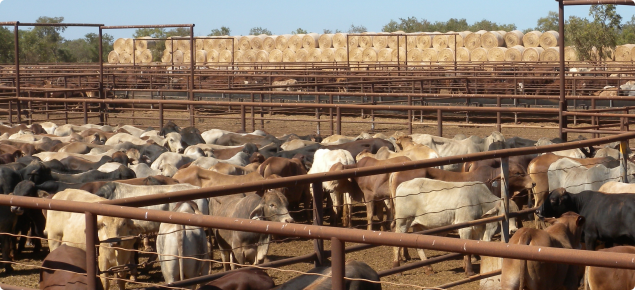Bluetongue virus is a reportable disease
Bluetongue virus (BTV) disease is a reportable animal disease under the Biosecurity and Agriculture Management Act 2007. The presence or suspicion of this disease must be reported immediately to the Department of Primary Industries and Regional Development (DPIRD).
To report signs of bluetongue disease, contact:
- your local veterinarian or DPIRD veterinarian
- after hours: Emergency Animal Disease hotline on 1800 675 888.
Any detection of bluetongue virus antibodies on serum testing by your veterinarian is also reportable.
How bluetongue is spread
The transmission of the bluetongue virus requires an insect vector. Some species of Culicoides or biting midges can spread bluetongue virus. Of the 180 species of Culicoides midges in Australia, only six species occurring in northern Australia have been shown to be capable of spreading bluetongue virus.
Bluetongue virus only occurs where there is a suitable environment for the vector. The midge requires some moisture, warmth and vegetation to persist and so mainly occurs in tropical and subtropical regions of the world.
Bluetongue virus spread is most likely to occur when the Culicoides midge is active in late summer and autumn.
Nine of the 24 known strains (serotypes) of bluetongue virus have been identified in Australia. Many of the strains that cause severe disease in Europe, Africa, the Middle East, China and India are exotic to Australia. The most common serotypes found in Australia are bluetongue virus 1 and 21, which have a low virulence. New serotypes are most likely introduced to Australia via infected midges carried on winds from Southeast Asia.
Signs of bluetongue virus disease
When bluetongue virus causes disease in ruminants, it damages the blood vessels causing leakage, poor blood supply to extremities and poor blood clotting. This leads to haemorrhages being visible where the skin is damaged. The incubation period from an animal being bitten by an infected midge to clinical signs is four to seven days.
Disease signs resulting from bluetongue virus are usually only seen in sheep and can be serious. These include:
- fever (40–41°C) for 5–6 days
- stiffness, lameness and arched back stance
- reddening around the coronary band (top of the hoof)
- clear nasal discharge which may become thicker and blood-stained
- drooling and salivation
- swelling of the lips, tongue and head
- membranes of the mouth and lips may become reddened
- death rates of 20–40% but may be as high as 70% in sheep.
Which animals are most at risk?
All ruminant animals, including sheep, goats, cattle, buffaloes and deer, are susceptible to the bluetongue virus.
Sheep are the most susceptible and may show obvious disease signs. Some breeds of sheep are more likely to be affected than others. British breed and Merino sheep are particularly susceptible.
Infection in cattle generally occurs with no obvious clinical signs but they provide a reservoir for the virus to be spread when suitable midges bite them and then other animals.
Prevention
Bluetongue virus will spread only where there is a suitable midge vector.
Controlling the midge in extensive farming systems is not considered possible.
The most important way to protect Australia from bluetongue disease is by restricting sheep from regions where the virus and its vectors occur (such as in the Kimberley). In Western Australia the keeping of sheep in the Kimberley is strongly discouraged and producers are requested to contact DPIRD for advice.
If moving cattle from within the bluetongue zone to properties outside the zone into areas where the midge sometimes occurs (such as the southern Kimberley and the Pilbara), only move them when the midge is not likely to be active (preferably late winter or early spring).
A current map of the bluetongue zone in Australia is available on the Animal Health Australia website.
Surveillance for bluetongue virus
DPIRD contributes to Australia’s National Arbovirus Monitoring Program (NAMP), which monitors the distribution of economically important insect-borne viruses of livestock and their vectors.
NAMP specifically monitors for bluetongue virus, Akabane and bovine ephemeral fever (three-day sickness). It provides a system for detection of any new strains of bluetongue virus and any change in distribution of these viruses within Australia.
Producer and veterinarian NAMP forms are available to download from the Animal health surveillance forms webpage.
Market implications of bluetongue virus
Live export trade is a very important part of the economic viability of the Australian sheep, goat, beef and dairy cattle industries. The excellent record of a very good health status in Australian livestock is critical to our access to these markets.
Bluetongue virus is present in some cattle herds in the Kimberley of WA, the Northern Territory, Queensland and New South Wales. This area is defined by an internationally recognised bluetongue virus zone. The majority of WA’s livestock reside outside the bluetongue virus zone, making WA an attractive place for bluetongue sensitive countries to source stock.
Bluetongue disease (when the bluetongue virus causes clinical signs of infection in an animal) has never occurred in Australia. Many of the countries that import sheep, goats, beef and dairy cattle require the country of origin to be free from bluetongue disease.
Diseases that may resemble bluetongue disease
Other serious diseases that may look like bluetongue disease include:
- foot-and-mouth disease (reportable disease)
- epizootic haemorrhagic disease (reportable disease)
- sheep pox (reportable disease)
- footrot (reportable disease)
- peste des petits ruminants (reportable disease)
- photosensitisation
- scabby mouth.
Reporting disease signs
If you see signs that resemble bluetongue disease, report it immediately to your local veterinarian, DPIRD veterinarian, or the Emergency Animal Disease hotline on 1800 675 888.
Your local veterinarian or DPIRD veterinarian will be able to provide advice and take samples to investigate and diagnose the disease. These investigations can be subsidised through the Significant Disease Investigation program.

